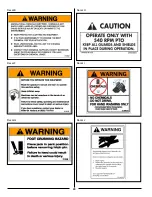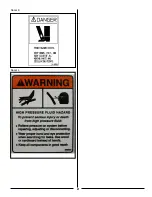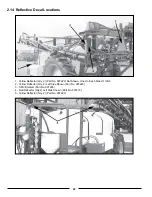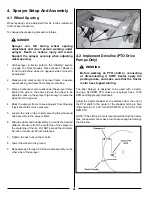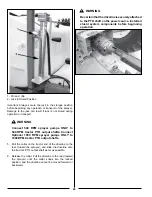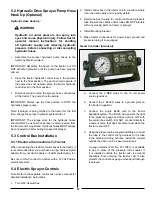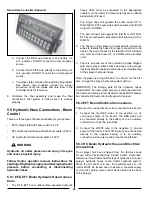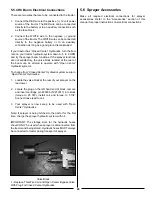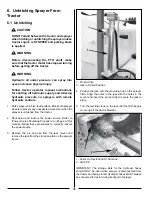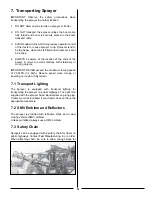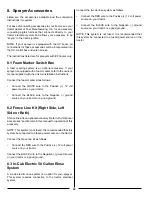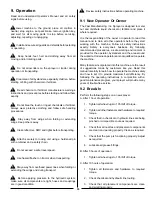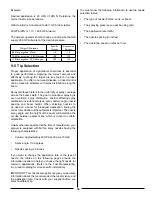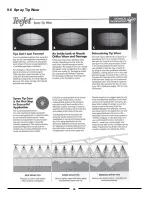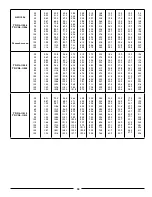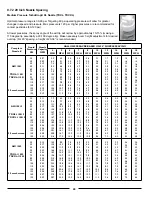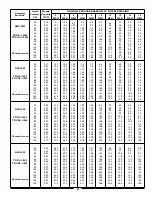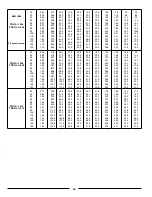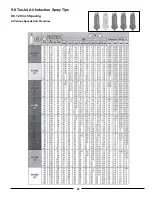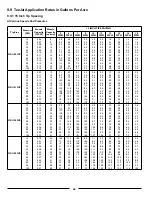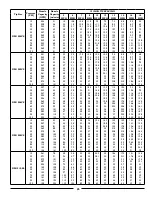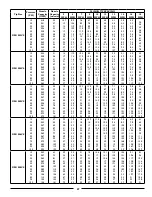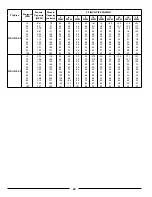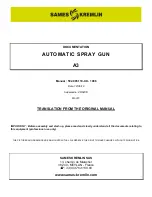
34
D. After 50 hours of operation:
1. Tighten all wheel lugs to 135 lb/ft of torque.
2.
Then follow normal servicing and maintenance
schedule as defined in Maintenance Section.
9.3 Pre-Operation Checklist
Efficient and safe operation of the Fast Manufacturing, Inc.
Sprayer requires that each operator reads and understands
operating procedures and all related safety precautions
outlined in this section. A pre-operational checklist is
provided for the operator. It is important for both personal
safety and maintaining the good mechanical condition of
the sprayer that this checklist be followed.
Before operating sprayer, check the following items:
1.
Lubricate machine per schedule outlined in “Maintenance
Section”.
2. Use only a tractor of adequate power and weight to
operate sprayer.
3.
Be sure that machine is properly attached to tractor.
Be sure that a mechanical retainer is installed through
drawbar pin and safety chain is installed.
4.
Inspect all hydraulic lines, hoses, fittings and couplers
for tightness.
5.
Check tires and verify they are inflated to specified
pressure.
6.
Calibrate sprayer if at start of season or a new sprayer
rate is being used.
7. Check condition and routing of all fluid hoses and lines.
Be sure that all lines are routed in large arcs. Replace
any that are damaged. Re-route those that are rubbing,
pinched or crimped.
8. Check placement components. Remove and replace
any that are worn.
9. Remove all entangled material.
9.4 Measuring Travel Speed
Measure a test course in the area to be sprayed or in an
area with similar surface conditions. Minimum lengths of
100 and 200 feet are recommended for measuring speeds
up to 5 and 10 miles per hour, respectively. Determine the
time required to travel the test course.
To help ensure accuracy, conduct the speed check with a
loaded sprayer and select the engine throttle setting and
gear that will be used when spraying. Repeat the above
process and average the times that were measured. Use
the following equation or the table to determine ground
speed.
Speed
(mph)
Travel Time Required (seconds)
100 Feet
200 Feet
300 Feet
3.0
23
45
68
3.5
20
39
58
4.0
17
34
51
4.5
15
30
45
5.0
14
27
41
6.0
-
23
34
7.0
-
19
29
7.5
-
18
27
8.0
-
17
26
9.0
-
15
23
Useful Formulas and Conversions
GPA=
Application rate in gallon per acre
GPM=
Flow rate in gallons per minute
S=
Speed in miles per hour
W=
Nozzle spacing in inches
Calculate flow rate per nozzle when application rate, speed
and nozzle spacing are known:
GPM (per Nozzle) = GPA x S x W
5940
Calculate application rate when nozzle spacing, speed and
flow rate are known:
GPA = 5940 x GPM
S x W
Calculate speed when flow rate, application rate and nozzle
spacing are known:
S = 5940 x GPM
GPA x W
Convert speed from feet per second to miles per hour:
S = Feet per second x 0.682
9.4.1 Spraying Solutions Other Than Water
Since all the tabulations are based on spraying water,
which weighs 8.34 lbs. per US gallon, conversion factors
must be used when spraying solutions which are heavier
or lighter than water. To determine the proper size nozzle
for the solution to be sprayed, first multiply the desired
GPM or GPA of solution by the water rate conversion factor.
Then use the new converted GPM or GPA rate to select the
proper size nozzle.
Содержание BW750
Страница 18: ...18...
Страница 19: ...19 Decal A Decal B Decal C Decal D...
Страница 20: ...20 Decal E Decal F Decal G Decal H Decal I Decal J...
Страница 21: ...21 Decal K Decal L...
Страница 36: ...36 9 6 Spray Tip Wear...
Страница 43: ...43 9 8 TeeJet Air Induction Spray Tips 9 8 1 20 Inch Spacing At Various Speeds And Pressures...
Страница 49: ...49 9 10 TeeJet FloodJet Wide Angle Flat Spray Tips 9 10 1 40 Inch Spacing At Various Speeds And Pressures...
Страница 57: ...57 Instructions Valve Settings For Accessory Kits Refer To The Operator s Manual For Detailed Instructions...
Страница 81: ...81 12 3 Raven Console Calibration Information...
Страница 83: ...83 Notes...

